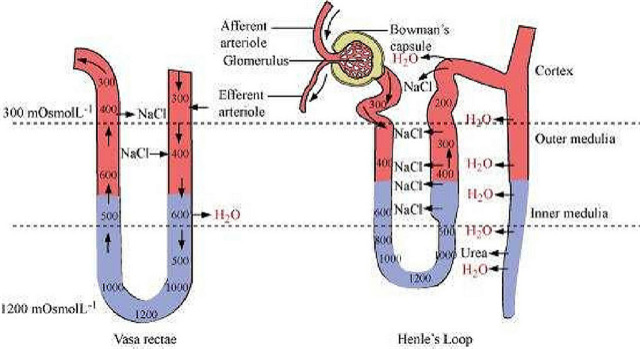
| A. Ammonotelism | (i) Birds |
| B. Bowman's capsule | (ii) Water reabsorption |
| C. Micturition | (iii) Bony fish |
| D. Uricotelism | (iv) Urinary bladder |
| E. ADH | (v) Renal tubule |
A. Ammonotelism | (i) Bony fish |
B. Bowman's capsule | (ii) Renal tubule |
C. Micturition | (iii) Urinary bladder |
D. Uricotelism | (iv) Birds |
E. ADH | (v) Water reabsorption |
The counter current mechanism operating inside the kidney is the main adaptation for the conservation of water. There are two counter current mechanisms inside the kidneys. They are Henle's loop and vasa rectae.
Henle's loop is a U-shaped part of the nephron. Blood flows in the two limbs of the tube in opposite directions and this gives rise to counter currents. The Vasa recta is an efferent arteriole, which forms a capillary network around the tubules inside the renal medulla. It runs parallel to Henley's loop and is U-shaped. Blood flows in opposite directions in the two limbs of vasa recta. As a result, blood entering the renal medulla in the descending limb comes in close contact with the outgoing blood in the ascending limb.
The osmolarity increases from 300 mOsmolL -1 in the cortex to 1200 mOsmolL -1 in the inner medulla by counter current mechanism. It helps in maintaining the concentration gradient, which in turn helps in easy movement of water from collecting tubules. The gradient is a result of the movement of NaCl and urea.
Glomerular Filtration Rate (GFR) is the amount of the filtrate formed by the kidneys per minute. GFR for a healthy individual is approximately 125 ml/minute. i.e. 180 litres per day.
Indicate whether the following statements are true or false.
B.
ADH helps in water elimination, making the urine hypotonic.C.
Protein-free fluid is filtered from blood plasma into the Bowman's capsule.D.
Henle’s loop plays an important role in concentrating the urine.E.
Glucose is actively reabsorbed in the proximal convoluted tubule.Explain the autoregulatory mechanism of GFR.
The kidney regulates the glomerular filtration rate by an autoregulative mechanism carried out by the juxtaglomerular apparatus.
The Juxtaglomerular apparatus is a special sensitive microscopic structure formed by cellular modifications in the distal convoluted tubule and the afferent arteriole at the location of their contact.
When there is a fall in the glomerular filtration rate, it activates the juxtaglomerular cells to release renin. This stimulates the glomerular blood flow, thereby bringing the GFR back to normal. Renin brings the GFR back to normal by the activation of the renin-angiotensin mechanism
